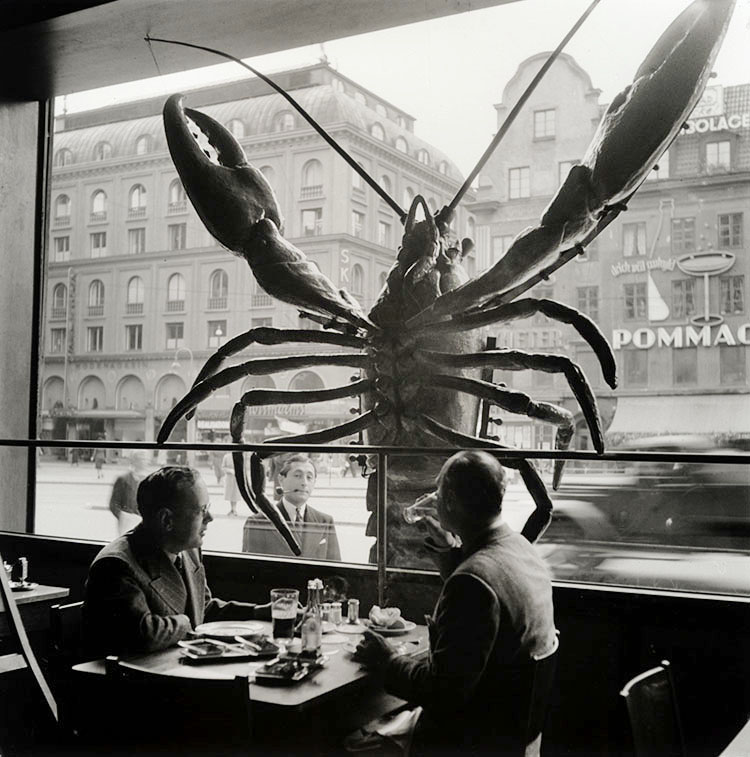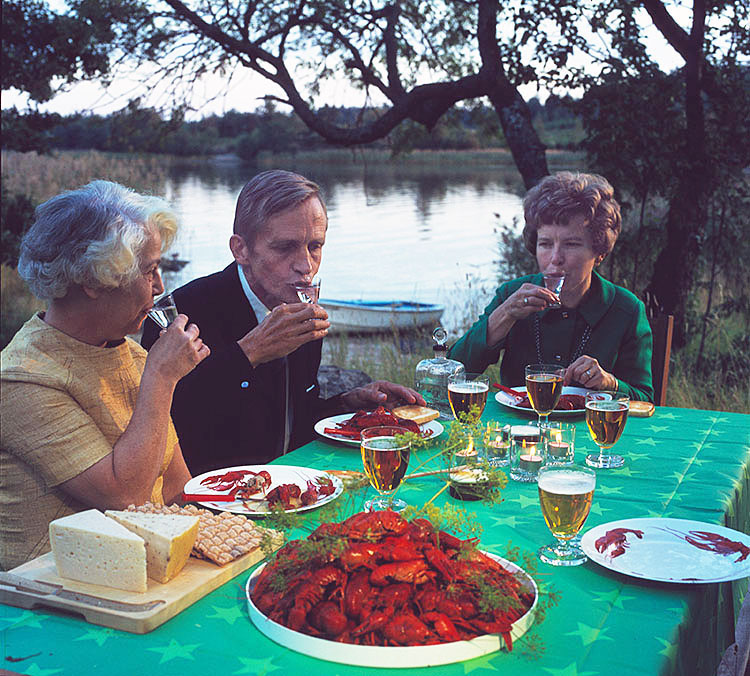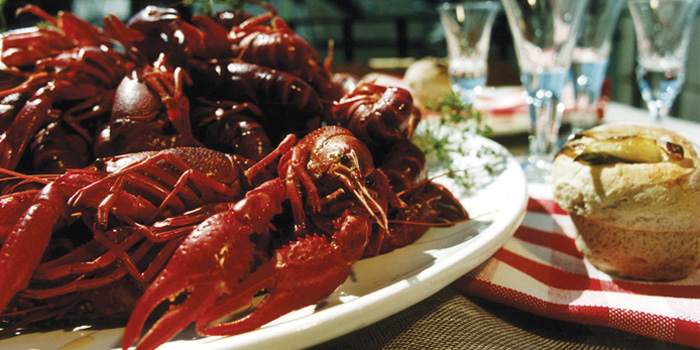Crayfish Cravings in California
While Swedes are well known for their reserved and civilized demeanor, for a few weeks in August they let their hair down and partake of an annual late-summer bacchanalian rite. The crayfish season is a time for Swedish restraint to be shed with a vengeance ...
-
 Crayfish Premiere at restaurant Sturehof in Stockholm. Photo: K W Gullers, Nordiska museet.
Crayfish Premiere at restaurant Sturehof in Stockholm. Photo: K W Gullers, Nordiska museet. -
-
By Sofia Englund
-
 A traditional Swedish kräftskiva a la 1960s. Photo Karl Erik Granath, Nordiska museet.
A traditional Swedish kräftskiva a la 1960s. Photo Karl Erik Granath, Nordiska museet. -
-
The end of Swedish summer brings crayfish season, and with it a host of “kräftskivor” (crayfish parties) where lanterns are strung above long picnic tables, bibs and silly hats are distributed and buckets of cold crustaceans are readied to be consumed between endless rounds of akavit.
-
 “The tables are decked in the orchard bower, The lanterns are glowing, the evening is warm..."
“The tables are decked in the orchard bower, The lanterns are glowing, the evening is warm..." -
The Swedish Kräftskiva is, next to Midsummer, the national holiday most closely associated with Swedish identity. While Swedes are well known for their reserved and civilized demeanor, for a few weeks in August they let their hair down and partake of an annual late-summer bacchanalian rite. Much like Midsummer, the crayfish season is a time for Swedish restraint to be shed with a vengeance.
-
This centuries-old tradition, celebrated in song and literature by the likes of August Strindberg, derives from a time when freshwater crayfish were almost exclusively consumed by the ruling elite. In fact, the first time crayfish are mentioned in relation to Swedish gastronomy is in a communication from King Erik XIV to the bailiff of Nyköping Castle dated 1562. In the letter, the king commands the harvesting of large amounts of crayfish for his sister Anna’s wedding.
-
With the rise of the Swedish middle class at the end of the 19th century, crayfish, served whole and cold after being boiled in salted water and seasoned with dill, began to be enjoyed by a much larger population. This sudden and massive increase in crayfish consumption and its depletive effect on the domestic crustacean population prompted legal regulation of crayfish catches: Harvesting was thus forbidden from November until August 7.
-
And so the tradition of crayfish parties in August was begun. In 1994, these restrictions were rescinded, but Swedes continue to honor the tradition of premiering the crayfish season in early August.
-
Crayfish US-style
For decades, Swedes have devoured crayfish imported from the United States in order to fill the gap left by the depletion of native Swedish crustaceans, when they fell victim to a fatal fungus. The Swedish “crayfish pest” first appeared at the turn of the 20th century, but it was not until the 1970s that a serious shortage of the domestic strains became apparent. -
Dropping the yearly crayfish festivities in the face of dwindling Swedish supplies was, of course, never considered a possibility. So today, Sweden also imports crayfish from Turkey, Spain and China. Domestic Swedish crayfish continue to be sold, albeit at a premium price for its native qualities, but are in fact often American in origin (signal crayfish —Pacifastacus leniusculus). These crustaceans were planted in Swedish lakes following the outbreak of the crayfish pest.
-
Americans may be more familiar with crayfish, ("crawfish," "crawdads," "mudbugs") prepared hot to Louisiana Cajun tastes and in fact the greatest diversity of crayfish species is still found in the southeastern part of the United States; 98 percent of the crayfish harvested in the U.S. come from Louisiana. The Atchafalaya Basin, a vast Louisiana wetland, is to crayfish production what West Texas was once to oil. There, huge rice paddies double as crayfish reservoirs, and enormous quantities of crayfish, often heaped out on newspapers, are consumed each year in cajun delicacies such as crawfish pie. Swedes, however, still prefer their crayfish boiled, cold and dilled — and washed down with akavit and a beer chaser.
-
Chamber Crustaceans
Considering the paucity of meat on the six-inch-long crayfish, some argue that Swedish mosquitos may eat better than Swedes at a traditional outdoor Kräftskiva. But it is not only the crayfish but also the akavit, the songs and the socialization that make for a successful Kräftskiva. -
At the Swedish-American Chamber of Commerce’s Annual Crayfish Party on August 8, we offer our guests a festive evening with silly hats, bibs, snaps, Västerbotten cheese and pies, knäckebröd (crisp bread) and gravad lax (salmon Swedish-style) and yes, crayfish. In fact, you will find all the traditional delicacies and accoutrements found in Sweden — except the mosquitos!
-
Welcome!
-
Event Info
Friday, August 8, from 6 p.m. to 11 p.m.
Norwegian Club, 1900 Fell Street, San Francisco, CA 94117
Sign Up Now! -
Find more info, snaps recipes and links to the important songs here: An Ode to the Crayfish
-
-
